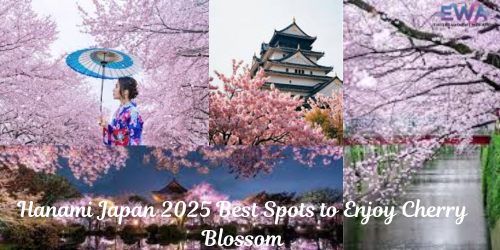Hanami Japan : Every spring, Japan changes into a magnificent painting of soft pink petals and delicate blossoms, capturing the heart and soul of the nation’s treasured tradition: Hanami (or “flower viewing”). Explore the top hanami places around Japan in 2025, joining residents and foreigners in celebrating this timeless celebration.

What is hanami Japan?
A celebration of nature’s fleeting beauty. Hanami is an old Japanese ceremony that honors ephemeral flowers, primarily cherry blossoms (sakura), but also plum blossoms (ume). Hanami, which takes place from late March to early May (and as early as mid-January in subtropical Okinawa), celebrates the entrance of spring and the beauty of impermanence.
Origins: From Imperial Courts to Popular Festivals.
The practice began during the Nara era (710-794), when plum blossoms were honored. It was inspired by Chinese habits of savoring poetry and wine under blossoming trees (Wikipedia). By the Heian era (794-1185), cherry blossoms had taken center stage—particularly in poetry genres like waka and haiku—and hanami became synonymous with sakura.
During the Heian era, Emperors conducted magnificent hanami parties in Kyoto, where they gathered under flowering cherry trees to dine, drink sake, and create poems, reflecting the ephemeral beauty of life. During the Edo era, when shoguns such as Tokugawa Yoshimune planted cherry trees to promote public festivals, this noble habit gradually extended to samurai and subsequently to regular people.
Oktoberfest Munich 2025
From Bento to Dango: Festive Food and Drink.
A hanami wouldn’t be complete without the customary seasonal fare. As well-known as the flowers themselves are the treats that may be enjoyed beneath the blossoms, such as a bento box, sweet dango (rice dumplings), or sake while the petals swirl overhead. The sly allusion to the enthusiastic feasting that usually trumps the genuine flower gazing is the Japanese expression “hana yori dango”—”dumplings over flowers.”
Why Honor Hanami? Community, Culture, and Nature
Hanami is a vibrant fusion of natural wonder, cultural legacy, and communal joy that goes beyond simply being a stunning vacation. It honors centuries-old customs, celebrates the beauty of impermanence, and unites people to feast and revel beneath fleeting blossoms. Hanami will continue to serve as a reminder of the transient nature and beauty of life in 2025, when weather patterns change and blossoms appear earlier than ever






